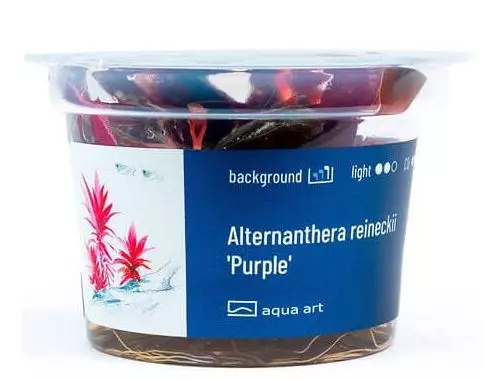Product information "Alternanthera reineckii 'Purple' (Purple parrot leaf)"
Alternanthera reineckii 'Purple'
Purple' is the largest variety of Alternanthera Reineckii. The red colored leaves make it a great plant for accenting.
- Difficulty of cultivation: difficult
- Light requirements: high
- CO₂ requirements: high
- Height of mature plants: 20-50 cm
- Growth: medium
- Temperature: 20-28°C
- Placement in aquarium: middle ground or background
- Origin: South America
- 6 cm cup diameter
Alternanthera Reineckii 'Purple' is a demanding plant for advanced aquarists. It should receive a fertile substrate, strong lighting, an additional supply of carbon dioxide and a full feeding in the form of liquid fertilizer. However, even under favorable conditions, its growth is very slow.
Alternanthera Reineckii 'Purple' is a secondary or tertiary plant. The top of the leaf blades are reddish brown, while the undersides range from purple to violet to dark red. The mature plant can grow up to 50 cm tall, but usually reaches no more than 20-30 cm in height. It spreads laterally by lateral stolons. To obtain cuttings, 7 cm long cut stems are inserted into the ground It presents best in the second or third level.
In nature, it is a swamp plant that occurs in South America.
The best growth results are obtained when it is planted in an active substrate. The growth rate depends on the carbon dioxide concentration in the aquarium water. It prefers soft to hard water with a pH of 6 to 8. It depends on the availability of macronutrients in the water column and is sensitive to macronutrient deficiencies resulting in the loss of leaves in the lower part of the stem.
Plant it in closely spaced clumps. As it grows, it will form a compact group of adult plants.
Prune the plant regularly with sharp scissors. Frequent pruning helps the plant compact and grow. To maintain the dark red color of the foliage, the plant must be well exposed to light. In optimal light, it grows densely and the internodes are short, making it look much more attractive. It makes an interesting contrast to the many green plants in the aquarium. In open aquariums it grows easily to the water surface.
Planting: The plant must be removed from the cup and thoroughly rinsed from the gel under running water. This is best done by placing the plant in a container of lukewarm water. Most of the gel will then fall off by itself. Divide the contents of the cup into 3-4 cm lumps and then place them in the substrate.
.

















.jpg)












